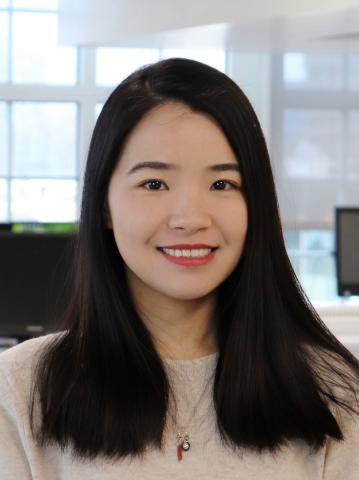個(gè)人簡(jiǎn)介:
?
倫敦瑪麗女王大學(xué)生物醫(yī)學(xué)材料博士,倫敦大學(xué)國(guó)王學(xué)院藥學(xué)系Maplethorpe Fellow (成立以來(lái)首位中國(guó)女性獲得者),碩士生導(dǎo)師,深圳市海外高層次人才。目前共主持國(guó)家級(jí)(2項(xiàng)),省級(jí)(1項(xiàng)),市級(jí)及其他(3項(xiàng))科研項(xiàng)目共6項(xiàng)。發(fā)表高水平SCI論文50余篇,其中一作/通訊代表性論文包括有Nature Communications,Advanced Science(封面),Small,Biosensors & Bioelectronics等。任ACS Nano,Advanced Functional Materials,Journal of Controlled Release,Biomaterials等領(lǐng)域權(quán)威學(xué)術(shù)期刊的審稿工作,任BioNanoScience期刊編委,Journal of Visualized Experiments等期刊客座編輯。獲2019年中國(guó)“硬科技”創(chuàng)新創(chuàng)業(yè)大賽一等獎(jiǎng),2020年深圳市創(chuàng)新創(chuàng)業(yè)大賽晉級(jí)決賽。近5年,以第一發(fā)明人申請(qǐng)發(fā)明專利5件,授權(quán)1件。參編專著3部,其中英文2部,教育部十四五規(guī)劃教材1部。指導(dǎo)本科生獲“全國(guó)大學(xué)生基礎(chǔ)醫(yī)學(xué)創(chuàng)新研究實(shí)驗(yàn)室設(shè)計(jì)競(jìng)賽”全國(guó)金獎(jiǎng)+最佳團(tuán)隊(duì)合作獎(jiǎng),中山大學(xué)附屬第七醫(yī)院首屆杰出教學(xué)獎(jiǎng)獲得者。
?
研究方向:
1.生物材料與生物界面、生物分子(核酸,蛋白等)之間的相互作用機(jī)制。
2.生物材料在腫瘤早期診斷,免疫治療,再生醫(yī)學(xué)中的研究。
3.細(xì)胞外囊泡的工程化及在疾病診療中的機(jī)制及應(yīng)用研究。
?
近五年代表論文:(#co-first authors, *corresponding author(s))
?
1. R. Cui#, H. Yang#, M. Kang*, D. Wang*, B. Tang*, D. Li*. Antibacterial hydrogel dressing with Ca2+-dependent hyaluronidase responsiveness for accelerating wound healing via on-demand release of AIE photosensitizers. Exploration, 2025.
2. X. Hao#, Y. Liu#, Y. Wen#, et al., D. Li*, L. Xu*. Two-pot ready-to-use reagents achieved quadruple-signal amplification for the ultra-sensitive biosensing of salmonella typhimurium in foods. Biosensors & Bioelectronics, 2025.
3. C. Hou#, S. Wang#, Z. Li#, et al.,?D. Li*, Y. Xu*. Curcumin-primed milk-derived extracellular vesicles remodel hair follicle microenvironment for the treatment of androgenetic alopecia. Regenerative Biomaterials, 2025.
4. X. Zhou#, B. Tang#, et al., L. Xu*, R. Ou*, Y. Xu*, D. Li*. Engineered mesenchymal stem cell‐derived extracellular vesicles scavenge self‐antigens for psoriasis therapy via modulating metabolic and immunological disorders. Advanced Science, 2025. (Cover story)
5. R. Cui, et al. L. Xu*, D. Li*. AI-assisted smartphone-based colorimetric biosensor for visualized, rapid and sensitive detection of pathogenic bacteria. Biosensors & Bioelectronics, 2024.
6. Z. Li#, X. Liu#, N. Cai#, et al., C. Zhang*, Z. Wei*, D. Li*. Immune checkpoint reprogramming via sequential nucleic acid delivery strategy optimizes systemic immune responses for gastrointestinal cancer immunotherapy. Cancer Letters, 2024.
7. Y. Liu#, P. Li#, et al., D. Li*, D. Shi*, L. Xu*. Metal-organic frameworks (MOFs) and covalent organic frameworks (COFs)-based prototyping of integrated sensing devices for robust analysis. Trends in Analytical Chemistry, 2024.
8. Q. Wu, et al., L. Xu*, D. Li*. Photothermal ferrotherapy-induced immunogenic cell death via iron-based ternary chalcogenide nanoparticles against triple negative breast cancer. Small, 2024.
9. Q. Huang#, Y. Jiang#, Y. Cao#, et al., D. Li*, Q. Liu*, F. Li*. Bone-targeting engineered milk-derived extracellular vesicles for MRI-assisted therapy of osteoporosis. Regenerative Biomaterials, 2024.
10. J. Zhao, et al., D. Li*. Exosome-driven liquid biopsy for breast cancer: recent advances in isolation, biomarker identification and detection. Extracellular Vesicle, 2022.
11. R. Cui, et al., X. Zhan*, D. Li*. Polysaccharide-based hydrogels for wound dressing: design considerations and clinical applications, Front Bioeng Biotechnol, 2022. (Top cited paper)
12. A. Raynold#, D. Li#, et al., J. Gautrot*. Competitive binding and molecular crowding regulate the cytoplasmic interactome of non-viral polymeric gene delivery vectors. Nature Communications, 2021.
13. D. Li,?et al., K. Al-Jamal*. Tailoring the architecture of cationic polymer brush modified carbon nanotubes for efficient siRNA delivery in cancer immunotherapy. ACS Applied Materials & Interfaces, 2021.
14. D. Li#*, L. Xu#, et al., Gautrot*. Responsive polymer brush design and emerging applications for nanotheranostics. Advanced Healthcare Materials, 2021. ?
15. L. Xu#*, D. Li#, et al. Facile biosensors for rapid detection of COVID-19. Biosensors & Bioelectronics, 2020.
16. J. Wang, et al., D. Li*. Micro-patterned surface construction on BCP ceramics and the regulation on inflammation-involved osteogenic differentiation. Materials & Engineering C, 2020.
17. J. Wang, et al., D. Li*. Fabrication and preliminary evaluation of the osteogenic potential for micro-/nano-structured porous BCP ceramics. Ceramics International, 2020.
?
參編專著:
1.吳強(qiáng)#,崔榮偉#,李丹陽(yáng)*。《納米生物醫(yī)藥學(xué)》。第四章?藥用生物材料與納米載體。化學(xué)工業(yè)出版社,2025.
2.?D. Li, K. Al-Jamal*. Design and delivery of siRNA therapeutics. Chapter 12 SiRNA design and delivery based on carbon nanotubes. H.J. Ditzel, M. Tuttolomondo, S. Kauppinen (Eds.), Methods in Molecular Biology, 2021.
3. D. Li, J. Gautrot*. Polymer and Biopolymer Brushes.?Chapter 20 Design of polymer brushes for cell culture and cellular delivery: for materials science and biotechnology. Wiley, December, (2) 2017, 557-603.
?
招生信息:
報(bào)考專業(yè):分子醫(yī)學(xué)(大類:基礎(chǔ)醫(yī)學(xué));要求背景:基礎(chǔ)醫(yī)學(xué)、分子生物學(xué)、藥學(xué)、材料學(xué)、化學(xué)等;希望性格開(kāi)朗,陽(yáng)光積極,有良好的英文聽(tīng)說(shuō)讀寫能力,有良好的學(xué)術(shù)訓(xùn)練。
?
招聘信息:
招聘崗位:研究實(shí)習(xí)員
學(xué)歷要求:碩士/博士
專業(yè)要求:基礎(chǔ)醫(yī)學(xué),生物醫(yī)學(xué)工程,藥學(xué)等相關(guān)專業(yè),從事過(guò)于本課題組研究方向相符合的課題
其他要求:品行端正,為人正直,性格開(kāi)朗,無(wú)不良記錄,有良好的科研思維,受過(guò)良好的科研訓(xùn)練和一定的科研追求,有獨(dú)立完成至少一個(gè)課題的科研經(jīng)歷,發(fā)表過(guò)至少一篇第一作者(不含共同)SCI論文,有良好的英文聽(tīng)說(shuō)讀寫水平,除本身課題外,能協(xié)助課題組PI完成日常的課題組管理工作。
待遇福利:待遇豐厚,具體面談,可申請(qǐng)單位住房,協(xié)助子女入學(xué)入托等其他福利。
申請(qǐng)方式:請(qǐng)將“個(gè)人簡(jiǎn)歷+代表作+畢業(yè)論文+推薦人聯(lián)系方式”,打包發(fā)送至[email protected],郵件名稱注明:研究實(shí)習(xí)員應(yīng)聘+單位+姓名
?
聯(lián)系郵箱:




